square - A closed two-dimensional shape (polygon) bounded by four straight-line segments of equal length (equilateral) joined at four equal (right) angles. The formula with which to find its area: the length of one side squared (see below). The distance between opposite corners is the square root (see below) of the sum of the square of two sides. A quantity is squared when it is multiplied once by the same quantity (for example, 4 squared=4x4=16). The square root is the divisor of a quantity that when squared gives the quantity (for example, the square root of 4 is 2, because 4/2=2, and 2x2=4).
Examples:


In these images, negative spaces have been shaped and placed among positive spaces so that a viewer can make closure on a square and a cube.
Examples of works in which squares are important elements:

Kasimir Malevich (Russian, 1878-1935), Black Square, [1913] 1923-29, oil
on canvas, 41 3/4 x 41 7/8
inches (106.2 x 106.5 cm), State Russian Museum, St. Petersburg.
See Russian art.
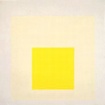
Joseph Albers (German-American, 1888-1976), Homage to the Square: Soft Resonance, 1962, oil on composition board, 48 x 48 inches (121.92 cm x 121.92 cm), Memorial Art Gallery, U of Rochester, NY.
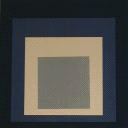
Joseph Albers, Day and Night VIII (from Homage to the Square), 1963, lithograph, 18 7/8 x 20 7/16 inches (47.94 x 51.91 cm), Memorial Art Gallery, U of Rochester, NY.

Joseph Albers, Homage to the Square: On Dry Ground, 1963, oil on Masonite, 40 1/4 x 30 3/4 inches (102.2 x 78.1 cm), California State University Library.

Frank Stella (American, 1936-), Hyena Stomp, 1962, oil
on canvas, 195.6 x 195.6 cm,
Tate Gallery, London. See Minimalism.
Also see angle, dado, frame, mathematics, oblong, parallelogram, polygon, quadrilateral, rectangle, rhombus, right angle, trapezium, and trapezoid.
square schematization - In architecture, a church plan in which the crossing square is used as the module for all parts of the design.
Also see cathedral and cruciform.
squinch - An architectural device used to make a transition from a square to a polygonal or circular base for a dome. It may be composed of lintels, corbels, or arches.
![]()
![]() Sri Lankan art - Sri Lanka is a tropical island nation southeast of India.
Sri Lankan art - Sri Lanka is a tropical island nation southeast of India.
Although known to Indians of early times as Lanka or Lankadweepa (meaning "Resplendent Land" in Sanskrit), Arabs called it Serendib, while its Portuguese, Dutch, and British colonizers called it Ceylon. The country achieved independence as Ceylon in 1948, and changed its name to Sri Lanka in 1972.
The two largest population groups on the island are the Sinhalese and the Tamils, each descended from peoples who arrived from southern India more than two thousand years ago. Although they have mixed to some degree, the Sinhalese and the Tamils maintain largely separate cultures, tensions between them having periodically turned violent. From the 1980s, such an ethnic war caused tens of thousands of deaths. A ceasefire has been in effect since late in 2001.
Example:

Sri Lankan, The Serpent Demon, a Kolam dancer's mask, 19th century, pre-1885, height 66 cm, British Museum, London. Sri Lanka is the island once known as Ceylon to the east of India. Kolam is a rural Sri Lankan form of drama involving both mime, dialogue, and dance, by actors who wear masks and costumes. The museum says, "The characters are divided into several types: humans (for example, princes, the drummer and his wife, the European), animals and demons, and the performances move from the depiction of village scenes to stories involving spirits and fabulous creatures from Hindu mythology. The Serpent Demon is a fierce character representing the evil power of snake poisons that can destroy human and animal life. The figure can be recognized partly by the presence of the cobras coiling to form a crown around its head and the snakes that emerge from its nostrils."
Related links:
Also see Buddhist art, flags of Asia, Hindu art, and Islamic art.
stabile - An abstract sculpture that has movable parts similar to a mobile, but that is attached to a solid, unmovable base rather than suspended. (pr. STAY-beel)
Examples by the originator of the term:

Alexander Calder (American, 1898-1976), Constellation, 1943, painted wood
and metal rods, 58.5 x 72.5
x 40 cm, Georges Pompidou Center, Paris.

Alexander Calder, Nageoire, c. 1964, painted metal,
455 x 510 x 610 cm, Georges Pompidou Center, Paris.
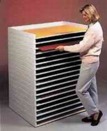
stack tray - An open shelf system, somewhat like a flat file system, each of which is especially suited for the storage of large, flat objects, such as sheets of paper, drawings, and prints. This system allows the purchasing of whatever number of stackable shelf trays as needed.
Also see bin and storerooms.
staff - A sculptural and architectural medium composed of plaster, cement, and jute fibers. This material was first used in buildings constructed for the Paris exhibition of 1878. It was also employed for many buildings and sculptures at the 1893 World Columbian Exposition in Chicago. Very few of these works still exist. Staff has proven to be suitable only for temporary works. Numerous sculptures for the Chicago exposition were executed in staff by Daniel Chester French (American, 1850-1931) and Edward Clark Potter (American, 1857-1923).
Stages of Artistic Development - Many people, including art educators have noticed that children's art making tends to follow certain patterns — stages in which it progresses as children grow from toddlers, through childhood and into adolescence.
Victor Lowenfeld (American) described several Stages of Artistic Development in children's art in his book Creative and Mental Growth, Macmillan Company, New York, 1947.
Lowenfeld's stages are:
1 . The scribble stage, typically occurring in children's drawings and paintings at ages 2-4 years old, is made up of four sub-stages:
2 . The preschematic stage (at ages 4-6)
3 . The schematic stage (at
ages 6-9)
4 . The dawning
realism stage (at ages 9-11)
5 . The pseudorealistic
stage (at ages 11-13).
Al Hurwitz (American) and Michael Day (American) have presented a somewhat different description of the stages of children's artistic development in their book, Children and Their Art, Harcourt Brace College Publishers, Texas, 1995.
Hurwitz and Day's stages are:
1 . The manipulative stage (at ages 2-5, in early childhood). Although comparable to Lowenfeld's scribbling stage, Hurwitz and Day see this as a period of exploration of new materials, straight and curving lines, beginning moving from simple gestures into more complex ones, developing into a sub-stage of naming what has been drawn, and further into another sub-stage of naming what is about to be drawn, heralding the onset of visualization.
2 . The symbol-making stage (at ages 6-9, American grades 1-4). This is comparable to Lowenfeld's schematic stage, in which a child produces shapes so that they'll stand for ideas — concepts of certain things. A paper surface is no longer simply a vessel for marks, but relates to the up and down of the world, with the bottom of the paper becomes a baseline and the top of the paper the sky line. Gradually a child recognizes a need for more and more details, as when a circle is no longer enough for a body — arm lines are added; and later arms have fingers. Color choices are no longer random, but take on meanings, as when blue must be for sky and green for grass and other plants. The child may represent things representations of things that are understood as having multiple layers by making X-ray-like pictures of them. New alternative means of showing a scene become possible:
3 . The preadolescent stage (at ages 10-13, American grades 5-8). A child is more self-critical and cautious. With early adolescent physical changes, a child experiences new social pressures. Expanding awareness bring challenges to a child's self-image and social position. Children may reasses their art skills with an emerging awareness of what people of all ages are capable of doing. This is generally a difficult, discouraging time, in which children progress in their artistic development only with well-paced instruction, seasoned with meaningful encouragement. Children are ready to add increasing detail, illusion of depth, subtle coloration, and increasingly sophisticated art techniques and processes.
Related links:
Also see children's art, multiple intelligence theory, and theory.
stainless steel - See steel.

stamp - To crush or grind with a heavy instrument as with a foot, or to form or cut out by application of a mold, form or die. Also, to imprint with a mark, design, or seal; or the device used to do so, such as the one shown here.
Also see chop, impression, numismatics, philately, relief, and signature.
standards - Expectations (also called benchmarks) for what students will learn; what educators are expected to teach students. In the USA, state and national standards have been formulated and passed into law as a result of a movement to hold schools accountable for teaching students skills that are considered essential. Although the primary focus for standardized testing has been in the disciplines of language and math, eventually students may well be assessed every discipline for which states have mandated standards. Although some art educators have been reluctant to see the arts assessed in this way, many others understand that our disciplines are greatly validated and strengthened by an effort which raises expectations that students must learn art skills.
Related resources:
Also see advocacy, art therapy, assessment, ASTM International (American Society for Testing and Materials), effort, masterpiece, science and art, teacher, and theory.
![]()
staple, staplegun, stapler - A staple is a U-shaped
metal form,
usually made of wire with chisel-pointed ends, that can
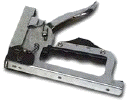 be driven into a surface
with a hammer or with a more
specialized device: either a stapler or a
be driven into a surface
with a hammer or with a more
specialized device: either a stapler or a staplegun. "Staple" is also
a verb meaning to drive a staple. Staples are most commonly used
on paper, corrugated
cardboard, and wood. Contemporary
painters typically attach canvas
to stretcher by stapling it with
a staplegun — either electric powered or spring-driven. Staples,
staplers, and stapleguns are commercially available in many types
and sizes, produced by many
manufacturers. Before their invention, what painters do with staples
was often accomplished with tacks and adhesives.
Also see frame, join, and nail.
state - The point at which a graphic artist makes a number of prints from his block, plate, stone or screen. If he alters his print design at all, this first series of impressions is called the first state. A second series, made after the design changes, is a second state. This can go on indefinitely until a final state is produced.
Also see standards and statue.
stationery - See letterhead.
stave - In architecture, a wedge-shaped timber; vertically placed staves embellish the architectural features of a building.
Also see wood.
stearin or stearine - A colorless, odorless, wax-like ester of glycerol and stearic acid, derived from animal and vegetable fats and used in candle and modeling waxes, and to supplement beeswax.
(pr. STEE-ə-rən)
steatite - Soapstone; a soft metamorphic rock composed mostly of the mineral talc. Soapstone is used in China for small figurative sculpture similar to work in jade, and in Byzantium it was used for sculpture similar to work in ivory. In India whole temples with highly ornate carving have been carved of steatite.
Also see Hindu art.
stein guss - German for cast stone, and refers to a specific material used in Germany for sculpture in the fifteenth century. It was entirely or mostly gypsum plaster.
(pr. sti:n gus)
stela - Alternative spelling of stele.
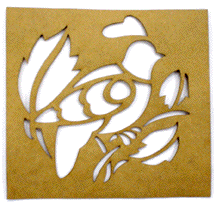 stencil - Stiff paper
(or other sheet material)
with a design cut into it as a template for shapes
meant to be copied. Ink
or paint forced through the
design's openings will produce a print
on a flat surface
placed beneath. The design need special to producing a stencil:
balance the requirement to cut out most of the desired shapes
against maintaining the strength of the loosest parts of the stencil.
The relationship between the positive
and negative spaces is best
when no part of the sheet is damaged or lost in its use. In lettering
stencils, for instance, the centers of such letters as A, B, D,
O, and P are some of the shapes most likely to have this problem.
The "bridges" holding these "islands" in position
are the chief characteristics of stencils. Art in which stencil
letters are used often make reference to flatness,
cheaply hand-produced signage
and package labeling, among
other common applications. Patterns
and other designs are also painted as stenciled architectural decorations.
Pochoir and silkscreening (or serigraphy)
are types of stencil processes.
Also, the image produced, and
the process of making it.
stencil - Stiff paper
(or other sheet material)
with a design cut into it as a template for shapes
meant to be copied. Ink
or paint forced through the
design's openings will produce a print
on a flat surface
placed beneath. The design need special to producing a stencil:
balance the requirement to cut out most of the desired shapes
against maintaining the strength of the loosest parts of the stencil.
The relationship between the positive
and negative spaces is best
when no part of the sheet is damaged or lost in its use. In lettering
stencils, for instance, the centers of such letters as A, B, D,
O, and P are some of the shapes most likely to have this problem.
The "bridges" holding these "islands" in position
are the chief characteristics of stencils. Art in which stencil
letters are used often make reference to flatness,
cheaply hand-produced signage
and package labeling, among
other common applications. Patterns
and other designs are also painted as stenciled architectural decorations.
Pochoir and silkscreening (or serigraphy)
are types of stencil processes.
Also, the image produced, and
the process of making it.
Examples:
.jpg)
Henri Matisse (French, 1869-1954), Icarus, 1947, color pochoir,
16 1/2 x 10 1/2 inches (image) 16 1/2 x 25.2 inches (sheet),
Metropolitan Museum of Art, NY. This is one of the twenty pictures
produced in this way by Henri Matisse for his book Jazz.
Also see cutout.

Alphabet designed for use in stenciling,
contemporary, sans
serif, uppercase, in a
style marketed especially for military
applications.
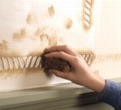
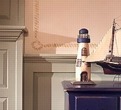
American, Nautical Rope Motif, contemporary wall stencil design,
for a home on the Atlantic Coast. This is typical example of
the use of this traditional
method of ornamenting walls,
ceilings, and floors: dabbing paint through stencils with a stiff
brush, a sponge, or a rag.

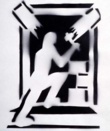

American, Reclaim Abandoned Buildings for the Homeless I and II, 1990s, spray-paint through a stencil onto paper, Washington, DC. These stencil designs were also used in
handbills produced in Washington, DC, by Homes Not Jails, "an autonomous group of individuals whose mission is to end homelessness and abolish the prison industrial complex."
Also see French curve, serigraphy, silkscreen, stipple, and text.
 Stendhal
syndrome or Stendhal's
syndrome - Dizziness, panic, paranoia, amnesia, or other nervous
conditions caused by viewing certain art
objects or by trying to see
too many works of art in too short a time.
Stendhal
syndrome or Stendhal's
syndrome - Dizziness, panic, paranoia, amnesia, or other nervous
conditions caused by viewing certain art
objects or by trying to see
too many works of art in too short a time.
The French novelist Stendhal (born Marie-Henri Beyle, 1783-1842) was 34 when he visited Florence, Italy, in 1817, and very shortly found himself overwhelmed by the city's legacy of art and history. When he visited Santa Croce (the cathedral in which Michelangelo, Machiavelli, and Galileo are buried) and saw Giotto's ceiling frescoes for the first time, he was overcome with emotion:
"I was in a sort of ecstasy, from the idea of being in Florence, close to the great men whose tombs I had seen. Absorbed in the contemplation of sublime beauty . . . I reached the point where one encounters celestial sensations . . . . Everything spoke so vividly to my soul. Ah, if I could only forget. I had palpitations of the heart, what in Berlin they call 'nerves.' Life was drained from me. I walked with the fear of falling.''
Much later, in the late 1970s, Dr. Graziella Magherini, then the chief of psychiatry at Florence's Santa Maria Nuova Hospital, noticed that a number of tourists who visited Florence were disoriented by the experience, suffering from symptoms ranging from temporary panic attacks to truly debilitating mental illnesses that lasted several days. Reminded that Stendhal had had similar symptoms, Dr. Magherini began to call it the Stendhal syndrome. (pr. sten-dahl' sin'drum, or, sin-drohm)
Quote:
Also see attention, beauty, déjà vu, forget, memory, mind, motivation, , obsession, sublime, theory, unconscious, and volute.
stereometry - Solid geometry — the science of measuring solids. Also the measuring of specific gravities with an instrument called a stereometer. See articles on various solid forms, such as those about sphere, cone, cube, and polyhedrons.
Also see science and art.
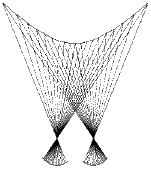
stereoscopic vision - Seeing with two eyes; also called binocular vision. Stereoscopic vision increases the ability to sense depth. Two-dimensional images don't take advantage of this capability, unless they present a different image on which each eye can fix. Several means have been devised to do this. Stereo photographs , sometimes called stereograms or stereographs have been produced since the mid-1800s. Popular since the early 1990s are computer-generated stereograms with images hidden inside of them. Other resources:
Also see binocular vision and photography.
stereotype - Preconceived and clichéd notions (biases or cognitive structures) that help individuals process information through associations between reality and the "pictures in your head." Stereotyping people often takes place in the social categories of race, national or ethnic groups, gender, class, generation or age group, profession, interest (geeks, nerds, jocks, skateboarders, chess-players), etc. Although stereotypes have often fed into xenophobic behaviors, stereotypes are not always negative. Because people are the products of their genes and their environment, they can form sweeping opinions about whole groups of people from the ways that people around them feel about and treat various people. The primary source for such notions is (or used to be) one's parents. The media — television, internet, etc. — have an increasingly powerful influence on the formation of stereotypes.
Example:

Viktor Nikolaevich Deni (Russian, 1893-1946), Antanta pod maskoi mira (The Entente under the mask of peace), 1920, 55 x 40 cm, New York Public Library. In this poster, published by the young communist government of Russia during that country's civil war (1918-1922), is a stereotypical fat capitalist who hides behind a mask of peace when he actually supports the defeat of communism. See propaganda.
Quote:
Stereotype is also a term specifying a certain printing process.
Also see aesthetics, analysis, angst, art criticism, artistic temperament, assessment, buckskin ceiling, censorship, critique, degenerate, discrimination, eccentric, empathy, ethnocentrism, Eurocentrism, existentialism, feminism and feminist art, First Amendment rights, iconoclast, iconomachy, iconophobia, interpretation, lookism, memory, motivation, multiculturalism, National Endowment for the Arts (NEA), obsession, pain, tradition, ugly, and xenophilia.
Sterling - Sterling silver is an alloy containing 92.5% silver and 7.5% copper, it is harder and more workable than pure silver. Symbol Ag; atomic number 47; melting point 960.8°C; specific gravity 10.50; valence 1, 2. A lustrous light-to-medium gray color.
stimulate, stimulus - To stimulate is to incite or rouse to activity, to a response. A stimulus is something that stimulates. The plural form is stimuli.
Quote:
Also see art criticism, enthusiasm, goal, inspiration, interesting, motivation, sense, simulation, and success.
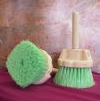 stipple
and stipple brush
- Stipple is a drawing, painting,
or engraving method
employing dots rather than
lines. Stippled works can be
produced with any of a variety of tools,
including pencils, crayons,
pens, and brushes.
stipple
and stipple brush
- Stipple is a drawing, painting,
or engraving method
employing dots rather than
lines. Stippled works can be
produced with any of a variety of tools,
including pencils, crayons,
pens, and brushes. The broadly
distributed bristles of this stipple brush are all the same length,
allowing the application of a mass of fine dots. A stipple brush is often used
by painters of faux textures
— simulating granite
and sandstone for instance.
An example of stipple work:

Edward Savage (American, 1761-1817), Liberty in the Form of the Goddess of Youth:
Giving Support to the Bald Eagle, 1796, stipple engraving on cream laid paper, Worcester
Art Museum, MA. See allegory.
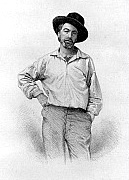
Samuel Hollyer (American, 1826-1919) after Gabriel Harrison, Walt Whitman (1819-1892), c. 1854-1855, stipple engraving on paper, sheet: 29 x 21.3cm (11 7/16 x 8 3/8 inches), National Portrait Gallery, Washington, DC. Whitman was 36 years old, and self-published the first edition of Leaves of Grass, 1855, using this picture for its frontispiece, and later wrote of it: "I look so damned flamboyant, as if I was hurling bolts at somebody-full of mad oaths-saying defiantly, to hell with you!" See portrait.
Also see mezzoprint, pointillism, and stencil.
stone - Concreted earthy or mineral matter; rock. Examples are marble, granite, limestone, alabaster, sandstone, schist, and soapstone. In the printmaking process of lithography, a piece of limestone is traditionally used as the printing surface. Also, a unit of weight measurement in Britain is a stone: equal to 14 pounds (6.4 kilograms).
Also see carving, chisel, gem, glyptics, igneous rock, living rock, metamorphic rock, mortar, mosaic, sculpture, sedimentary rock, statue, stipple, and suiseki.
storage - The place or space for the safekeeping of objects not currently being exhibited; containment for books, tools, or other materials that might be needed in the future — later today or years from now. Among the personality traits common to people immersed in the visual arts is the compulsion to accumulate stuff. We put tremendous energy into playing with our collections, much of it deciding where to put it all. We each have our ways of dealing with the stuff that lands on our floors, desks, tables, and so on. The quality of our storage becomes crucial. In the effort to store things well, we need to balance accessibility, safety, security, order, and cleanliness, against the limits of our time, energy, and other assets. In order to maintain the conservation of some things in storage, it may be necessary to control atmospheric temperature and humidity. The best types of storage also protect things from exposure to harmful vapors, light, fire, microbes, insects, and other creatures.
Also see art conservation, climate control, Collyers' Mansion, entropy, fumigation, hygrothermograph, glassine, material culture, flat file, polyethylene, polypropylene, preparator, silica gel, solander box, stack tray, and storerooms.
 storerooms - In museums,
these are the rooms and vaults in which some objects
are placed for study, protection, and future exhibition.
No museum has all of the objects
in its permanent collection
on display at any time. Just as the public generally doesn't get
to see backstage in a theater, it
rarely gets a look at the storerooms. But museum officials often
admit art students and art professionals who make appointments
with them to visit their storerooms.
storerooms - In museums,
these are the rooms and vaults in which some objects
are placed for study, protection, and future exhibition.
No museum has all of the objects
in its permanent collection
on display at any time. Just as the public generally doesn't get
to see backstage in a theater, it
rarely gets a look at the storerooms. But museum officials often
admit art students and art professionals who make appointments
with them to visit their storerooms.
Also see art conservator, collection, Collyers' Mansion, curator, director, flat file, gallery, hygrothermograph, and stack tray.
storyboard - A series of simple pictures that depict the important changes of scene and action in a planned film or video production. In the production of an animated film, for example, a series of sketches, comparable to a comic strip, which outlines the narration of a scene — its visual and audial changes. Traditionally, these drawings are tacked to a bulletin board, arranged, re-arranged and replaced as the story takes shape. Early rough storyboard drawings are thumbnail sketches, while more detailed drawings are called "finished" or "final storyboard panels."
Examples:

American, [detail] Storyboard of an Episode of
The Simpsons, c. 2000, pencil on paper.
Here's a second
and larger Simpsons storyboard.

Storyboard for a deep-sea diving video,
2002.

American, Storyboard for a televised public service announcement
(PSA), 2003. This video promotes the National Senior Service Corps (Senior Corps),
a network of programs that help older Americans find opportunities
to address community needs through volunteer service.

A form for a 21-frame storyboard, each frame accompanied
by spaces for dialogue and notes about movements,
music, and other effects.
Also see animation, panel, sequencing, and time.
straight - Extending continuously in the same direction without curves or other deviations, as might a line, edge, shape, form, space, etc. A straight angle is 180°. Some uses of straight imply a horizontal or vertical direction. Also, a quality of any communication that is direct, candid, or truthful. Or, neatly arranged, orderly, tidy, as when a mess is straightened up. Or, consecutive, uniterrupted; as when a show was open for three weeks straight. Or, heterosexual.
Also see aliased and anti-aliased, alignment, axis, bias, chronology, diagonal, diameter, dimension, freehand, gender issues, generatrix, geometric, grid, heterodox, length, light, meander, moiré, measure, movement, orthogonal, parallel, perpendicular, plane, polarizing, polygon, radius, ray, regular, sequence, tangent, and twist drill.
stress - The importance, significance or emphasis placed on something, or to place importance, significance, or emphasis upon something. In physics, an applied force or system of forces that tends to strain or deform an object.
Also see accent, architecture, carving, kerf, and modeling.

stretcher - Wooden bars, usually made of pine, that constitute a frame over which the canvas of a painting is stretched. Although stretchers can be any shape, most are rectangular. The edge of the canvas is attached to the stretcher with tacks, or with staples driven by a staplegun. The size of a stretcher can be changed slightly through the adjustment of keys (the small wedges visible in this example) or with expansion bolts at the four corners. A thin molding (3/4-round) should be attached to the outer edges of the stretcher, in order to keep the canvas from touching any surface other than those edges.
Related link:
structuralism - A school of art or of art criticism that advocates and employs a method of analyzing phenomena chiefly by contrasting the elemental structures of the phenomena in a system of binary opposition.
Quote:
Also see art history, formalism, isms and -ism, interpretation, meaning, Minimalism, and modernism.
structure - Something made up of a number of components that are put together in a particular way. Structure is any means of arranging or puting together a work to form a cohesive and meaningful whole, including sensory elements, organizational principles, expressive features, and functions of art. To give structure to a thing (to structure it) is to give form or arrangement to it. Sometimes structure refers to the elements of a thing that keep it from collapsing.
Quote:
Also see adobe, arch, architecture, armature, balloon framing, bearing wall, cement, coils, column, construct, cross-section, helix, homogeneity, interdisciplinary, join, lattice, plan, post and lintel, process, slab construction, steel, structuralism, Structurist, technique, and wood.
Structurist - Charles Biederman (American, 1906-2004) coined this term. Biederman said, "a Structurist work is neither painting nor sculpture, but a structural extension of the two." He studied art at schools in Cleveland and Chicago before years of painting in Paris and New York. Then he abandoned painting to produce painted "Structurist" geometric reliefs from 1937 onward.
Examples:

Charles Biederman, Structurist Relief, Red Wing No. 20,
1954-65, oil on metal,
104.8 x 14.9 cm, Tate Gallery, London.
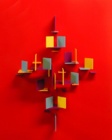
Charles Biederman, #35, Ornan, painted aluminum sculpture, 1971-73, 43 1/16 x 34 x 9 1/2 inches, Sheldon Memorial Art Gallery and Sculpture Garden, U of Nebraska, Lincoln.
stucco - The finest and whitest type of plaster used for modeling and molding. Stucco is made of a mixture of lime (often from marble), white-marble dust, and other ingredients, which might include wax, milk and other organic substances. A versatile medium in sculpture and in architectural decoration. Stucco can be either the material cast in a mold or the material of a mold, a material to be modeled in relief, or attached to something else. It is commonly used for covering walls and floors. Like all other dusts, airborne stucco is hazardous to breathe — every user must wear an appropriate face-mask. The surface of stucco must be sealed to keep dirt from building up in its pores — often accomplished with wax, shellac or linseed oil. Stucco lustro is a type of stucco with a higher ratio of marble dust, so that it can take a polish. Scagliola is another such variant.
(pr. STU-koh)
![]() stump
or stomp - A kind
of pencil consisting of a
tight roll of paper or soft leather,
or of a cylindrical piece
of rubber or other soft material
used for rubbing down hard lines
in pencil or crayon drawing, for blending
the lines of shading so as
to produce a uniform tint.
A stump may be used with any powdery pigment
such as graphite or charcoal,
spreading and rubbing it. The use of stumps was in greatest favor
in the eighteenth and nineteenth centuries. Although commercially
available today, the use of stumps has largely gone out of favor
in the last century. Also called a torchon
or tortillon.
stump
or stomp - A kind
of pencil consisting of a
tight roll of paper or soft leather,
or of a cylindrical piece
of rubber or other soft material
used for rubbing down hard lines
in pencil or crayon drawing, for blending
the lines of shading so as
to produce a uniform tint.
A stump may be used with any powdery pigment
such as graphite or charcoal,
spreading and rubbing it. The use of stumps was in greatest favor
in the eighteenth and nineteenth centuries. Although commercially
available today, the use of stumps has largely gone out of favor
in the last century. Also called a torchon
or tortillon.
An example of a drawing in which a stump was used:
![]()
Thomas Gainsborough (English, 1727-1788),
London, A Lady Walking in a Garden with a Child,
about 1785, black chalk
with stumping on light brown paper, heightened
with white pastel,
20 x 8 11/16 inches (50.5 x 22.1 cm), J. Paul Getty Museum, Malibu,
CA. See Rococo.
A related link:
Also see conté crayon and fixative.
stupa - In Buddhist tradition, a type of shrine.
stylize and stylization - To stylize is to alter natural shapes, forms, colors, or textures in order to make a representation in a preset style or manner. The design of any work tends to result in its having a style, and its having been freely chosen is one aspect of its appeal. "Stylization" suggests a more controled application of a style, the artist having less freedom of choice.
Examples of stylized works:

Mesopotamia, Weight in the Shape of a Sleeping Duck, c. 2000 - 1500 BCE, carved limestone, length 35.2 cm — an unusually large size; private collection, Europe. The massive and highly stylized bird is shown with a plump body and flaring tail, and easily transcends its original and somewhat prosaic function. The head, on an elongated neck, is turned to rest on the back. The simplified contours combine with the tactile surface invite comparison to sculptures by Constantin Brancusi and other modern sculptors. See Mesopotamian art and weight.

Henri Gaudier-Brzeska (English, born France,
1891-1915), Wrestlers, 1914, cast
c. 1965, plaster
relief, 71.1
x 92.7 x 7.6 cm, Tate Gallery, London. These figures are stylized and elongated.
Consistency can be seen either as a positive attribute, or as a negative one. Seen positively, when an artist's style remains the same, it might be interpreted as the artist remaining true to his or her experience or personality, or to an idea or an ideal, etc. Seen negatively, a consistent stylization might be read as overuse, monotony, artifice, lack of originality, lack of imagination, too rigidly ordered (controled), unfashionable, etc.
This is the war of two constant battles: the battle between new and old that's thrown together with the battle between consistency and change. We love newness; and all the more as children of the modern era. But because the change and its pace is stressful, we also cherish consistency, and selectively cherish the past.
Particularly in the postmodern era, artists have very consciously chosen historical styles in which to convey their art. One aspect of postmodernism has been to embrace the idea (heresy to modernists), that originality / creativity is either a less important or an impossible objective. (Note how common are copying, appropriation, sampling, and plagiarism, and questions about copyright issues.) The pursuit of newness was at the heart of modernism. But as much as postmodernists believe it cannot and should no longer be a goal, the zeitgeist still favors those who produce the next new thing. Advice to students: be aware that you might choose to employ any of many styles, and that your choice will affect the audience's interpretation of your work.
Also see anime, Art Deco, Art Nouveau, dance, and obsession.
stylobate - In architecture, the platform or foundation for a row of columns. On the Parthenon, the top step of the three-step platform is known as the stylobate. In each of the classical orders, the lower members of the platform can include the stereobate and the leveling course or euthynteria. The stylobate rests the base of the column, which support the entablature.
Examples:
Stylobates as they figure into a diagram of the Doric order and a diagram of the Ionic order.
Also see colonnade, Corinthian, Doric, Golden Mean, Greek art, Ionic, and Roman art.
stylus - A pointed instrument used to engrave into a softer surface.
Related link:
Also see burin, graffito, pen, and sgraffito.
Styrofoam® - A trademark used for expanded polystyrene plastic, a light-weight, granular material, usually worked in sheets or blocks, but also available in loose granules. It can be cut with great precision and ease with an electrically heated wire. Styrofoam is an economically attractive medium for use in theater and motion picture stage sets. Styrofoam is often mentioned in print as [lower-case s] styrofoam.
Quote:
Also see aggregate, foam core, and packaging.
https://inform.quest/_art